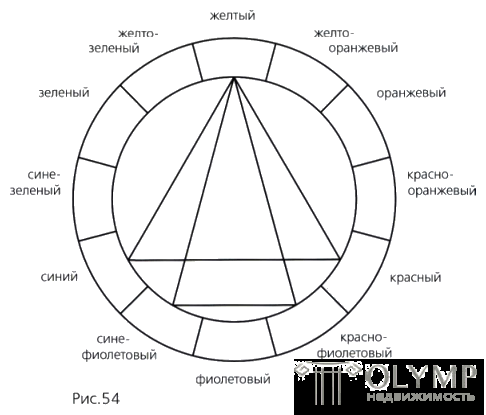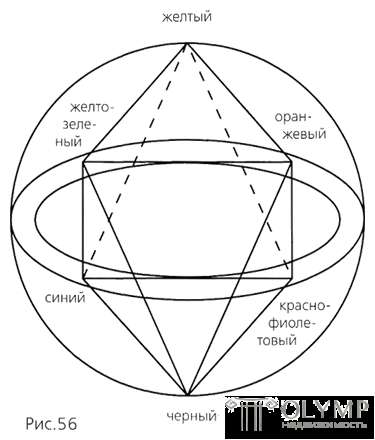
The concept of "color consonance" implies the possibility of the natural occurrence of color combinations, which serve as the basis for the overall color composition. Since it is impossible to consider all color combinations, we will confine ourselves only to the presentation of some principles of color consonance or color harmony.
Color consonance can be built on the basis of two, three, four or more colors. The consonance of two colors.
On the twelve-color color wheel, two diametrically opposed colors are complementary and form a harmonious combination consisting of two colors. Red - green, blue - orange, yellow - purple are harmonious combinations. If we use a color ball to build consonant color combinations, then we get almost any number of harmonious combinations of two colors. A prerequisite for such harmony is the condition of the symmetric arrangement of both colors relative to the center of the color ball. And so, if the clarified red color is used, then it corresponds to green, darkened to the extent that the red was clarified.
CONSCIOUS THREE COLORS.
If we select three colors from the twelve-part circle, the arrangement of which relative to each other forms an equilateral triangle, then these colors create a harmonious triad, as shown in Figure 54.

Yellow, red and blue are the most definite and strongest harmonious consonance that can be considered basic. The complementary colors of this trinity - purple, green and orange - also possess harmonious triad.
Yellow-orange, red-violet, blue-green or red-orange, blue-violet, yellow-green are other triads, each of which inside the color wheel forms an equilateral triangle.
If we are in tune with a pair of complementary colors, for example, yellow and violet, take two neighboring purple colors: blue-violet and red-violet, or vice versa, lying next to yellow: yellow-green and yellow-orange, then these harmonies also will be harmonious in nature, although in this case the geometrical figure connecting them will now be an isosceles triangle, as shown in Figure 54. If the figures of the triangles, and isosceles and equilateral, imagine inscribed in the color circle, then Single their vertices inside the disk as desired, it is possible to accurately determine a particular harmonic triad. In this case, there are two borderline cases where one of the vertices of the triangle is on the white or black pole. If we use an equilateral triangle, one of the vertices of which is in contact with white, then the other two vertices will point to the first darkened steps of a pair of additional colors. Then we, for example, get such a triad: white, dark blue-green and dark orange. If one of the vertices is in contact with black, then in a similar way we get black, clarified blue-green and clarified orange. These cases convince us that when using white or black, the contrast of light and dark comes into play.
CONSTELLING FOUR COLORS.
If we select two pairs of complementary colors from the twelve-sided circle, the connecting lines of which are perpendicular to each other, then we get the shape of a square, as shown in Figure 55. This results in three four-sounds: yellow, red-orange, purple, blue-green; yellow-orange, red, blue-violet, green; orange, red-violet, blue, yellow-green.

Other four-color consonances can be easily identified due to the shape of a rectangle that combines two pairs of additional colors, such as: yellow-green, red-violet, yellow-orange, blue-violet, or: yellow, violet, orange, blue.
The third figure for getting a four sound is the trapezium. Two colors are located next to each other, and two opposite colors are to the right and left of their complementary colors. Such combinations tend to a simultaneous change, although they are harmonious, forming a gray-black color when mixed.
By fitting the shapes shown in figure 55 into a color ball and turning them, you can get a very large number of new color combinations.
Hexagons can be obtained in two different ways.
In the twelve-piece color wheel, instead of a triangle or square, you can enter a hexagon. And then harmonious shesgizvuchie will be based on three pairs of complementary colors. Two such hexagons can be inscribed into it, consisting of yellow, violet, orange, blue, red, green and yellow-orange, blue-violet, red-orange, red-violet, yellow-green and blue-green. These hexagons can be placed in a color ball and, rotating them, get interesting color combinations based on clarified or darkened colors.

With the help of the triangle, which as the main figure is combined with white and black color, you can get the consonance of five colors. It may consist, for example, of the following colors: yellow, red, blue, black and white or orange, violet, green, white and black.
After all of the above, it becomes clear that the choice of color combinations and their modulations as the basis of an image cannot be arbitrary. It is clear that all the original moments are determined by the subject or abstract theme of the work chosen by the artist. However, the choice of color combinations and their development is an objective reality and the manifestation of caprice or surface speculation is inappropriate here. Each color and each color group is a kind of special individuality that develops and lives according to its own laws. The meaning of color consonance is to be able to achieve the strongest effect of color by correctly using color contrasts.
The main yellow-red-blue chord should show how from a constructively constructed consonance you can get different variations in their different color effects. One option is when yellow is between red and blue, the other is when red is between yellow and blue, or blue is between yellow and red. The colors of the main consonance can be combined with dark tones of pure colors, creating a contrast in saturation. All three colors could be darkened and brightened based on the contrast of light and dark. If all three colors were equally lightened and pure colors would be present here in the form of small stripes, this combination would give a contrast in the area of color spots. In the case when one color begins to dominate over the others quantitatively, an expressive color is achieved.
If you go that far and change any pure color of consonance to the one to the right and left of it, that is, replace yellow with yellow-green and yellow-orange, or red with red-orange and red-purple, and blue with blue-green and blue-violet, the combination consisting of three colors will turn into four sound, which will significantly enrich the possibilities of our variations.
These examples show that the theory of harmonious consonances does not at all seek to limit the imagination, but rather opens up wider possibilities for achieving various expressive manifestations of color.
Что бы оставить комментарий войдите
Комментарии (0)